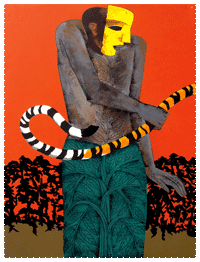- A fresh start
- Guest Editor’s Column
- Cast in Bronze
- The month that was
- Visual Diary
- Nomadic Detours
- Relation Next
- Lightness of being Anxious
- Necklace of Echoes
- The New Order Beauty
- Voyage
- Ribbed Routes
- Museum Talk
- Hard Talk
- Master Stroke
- Market Insight
- Artist Index and Statistics
- Auction Reports
- Creative Impulse
- Mid Century Modern : Retro Furniture
- 14th Kolkata Film Festival
- ABOHOMAN
- In the News
- Photo Feature
- Different hues of Aakriti
ART news & views
Lightness of being Anxious
Volume: 2 Issue No: 1 Month: 2 Year: 2010

Ashoke Mullick Explores Human Wishes
18 February to 13 March, Aakriti Art Gallery
 It is a wonder pondering about how pervasive, potent and persistent have been Picasso's visualinguistic legacy to modern Indian art; especially the clear linear enunciation of form-indicative phenomenon of the visible world, on two dimensional surface. Had such image formation been the only bequeathal, his inspiration would not have been so enduring. It was Picasso's mode of configuration of images into imagery, with strange spatial positioning and relative size and proportion-wise juxtapositions which gave to much of Picasso's oeuvre their suggestive narrativity, especially of humanist import, that proved to be a perennial source of inspiration for a number of our modernist artists, simply for the reason, that for many, the socially conditioned human existence was an overarching factor in mentality formation. It is for that reason that visualinguistics of much of Picasso came handy to many of our modernists,
It is a wonder pondering about how pervasive, potent and persistent have been Picasso's visualinguistic legacy to modern Indian art; especially the clear linear enunciation of form-indicative phenomenon of the visible world, on two dimensional surface. Had such image formation been the only bequeathal, his inspiration would not have been so enduring. It was Picasso's mode of configuration of images into imagery, with strange spatial positioning and relative size and proportion-wise juxtapositions which gave to much of Picasso's oeuvre their suggestive narrativity, especially of humanist import, that proved to be a perennial source of inspiration for a number of our modernist artists, simply for the reason, that for many, the socially conditioned human existence was an overarching factor in mentality formation. It is for that reason that visualinguistics of much of Picasso came handy to many of our modernists,  like Husain and Tyeb Mehta. It is for not for nothing that the 27 year old hitherto unknown Kolkata painter Ashoke Mullik received Husain's approbation in 1984 and Ashoke goes on visually quoting Tyeb Mehta, tellingly in his work.
like Husain and Tyeb Mehta. It is for not for nothing that the 27 year old hitherto unknown Kolkata painter Ashoke Mullik received Husain's approbation in 1984 and Ashoke goes on visually quoting Tyeb Mehta, tellingly in his work.
The 1957 Kolkata born and art educated Ashoke Mullick remains steadfast in his faith in Picassoesque narratology as an efficient mode for communication of humane concerns conditioned by social awareness. He refuses to prioritise obscure personal fetish-oriented preoccupations in his paintings, in spite of that kind of change overtaking the art practice in course of last two decades. It is, however, not that his own art practice has not changed. It indeed has changed over the years. But these changes have been within the parameters -- both visualinguistic and contentwise, he had set for himself years back. The present Aakriti show of Ashoke has been done in the last two years, do not depend so much on elaborate configuration of images in sequences, and he has done away with any suggestion of locale. In that sense, a densification through sparseness has come over to intensify visual thinking. Through manipulation of relative size of images in juxtaposition and placements on surface, he has achieved the success of giving to certain of the images in his present work symbolic presence. This has given to his present suit of work some depth-wise hites, oranges and cooler blues of yester years.suggestivity.  In tune with Ashoke's -- should we say -- graying mood, his palette has changed in a significant manner. In whatever colour he chooses now, darker hues are prominent, gone are the brighter and lighter yellows, whites, oranges and cooler blues of yester years.
In tune with Ashoke's -- should we say -- graying mood, his palette has changed in a significant manner. In whatever colour he chooses now, darker hues are prominent, gone are the brighter and lighter yellows, whites, oranges and cooler blues of yester years.
 Ashoke's present suit of paintings in oils and acrylics on canvas and drawings on paper are visually read like character-centric (not self- centric) novels. Characters are lonesome individuals, but always are persons with specific social callings and positions. They gaze or they dream, or hallucinate with open or closed or blinded eyes -- their unfulfilled wishes, hope, aspirations, desperations, and hopelessness. The world, Ashoke reveals, are the visages of the worlds these specifically socially situated persons dream or hallucinate, desire or dread. What we observe is always the artist's conception of the world around and not the outpourings of an indulgent self. But the viewer, being a person belonging to the world around, can empathise more than when he/she confronts a non-communicative artifact.
Ashoke's present suit of paintings in oils and acrylics on canvas and drawings on paper are visually read like character-centric (not self- centric) novels. Characters are lonesome individuals, but always are persons with specific social callings and positions. They gaze or they dream, or hallucinate with open or closed or blinded eyes -- their unfulfilled wishes, hope, aspirations, desperations, and hopelessness. The world, Ashoke reveals, are the visages of the worlds these specifically socially situated persons dream or hallucinate, desire or dread. What we observe is always the artist's conception of the world around and not the outpourings of an indulgent self. But the viewer, being a person belonging to the world around, can empathise more than when he/she confronts a non-communicative artifact.